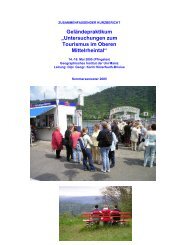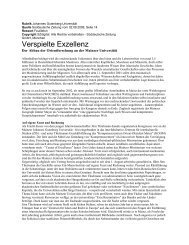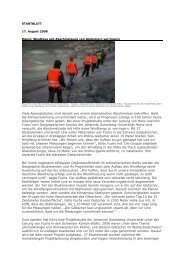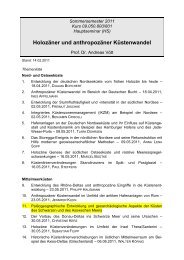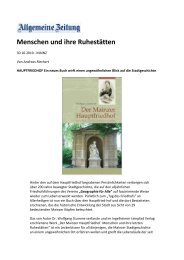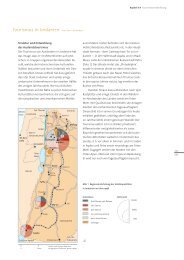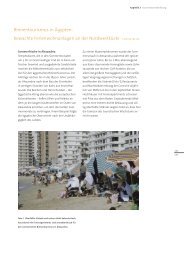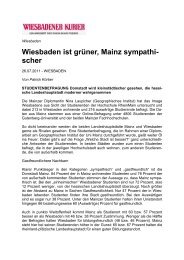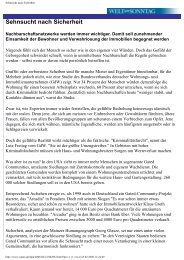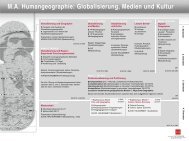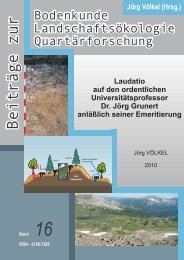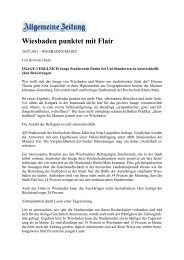Proceedings - Johannes Gutenberg-Universität Mainz
Proceedings - Johannes Gutenberg-Universität Mainz
Proceedings - Johannes Gutenberg-Universität Mainz
Create successful ePaper yourself
Turn your PDF publications into a flip-book with our unique Google optimized e-Paper software.
2 nd INQUA-IGCP-567 International Workshop on Active Tectonics, Earthquake Geology, Archaeology and Engineering, Corinth, Greece (2011)<br />
EARTHQUAKE<br />
ARCHAEOLOGY<br />
INQUA PALEOSEISMOLOGY<br />
AND ACTIVE TECTONICS<br />
STRUCTURAL CHARACTERISTICS AND EVOLUTION OF THE YANGSAN-ULSAN FAULT<br />
SYSTEM, SE KOREA<br />
S.-R. Han (1), M. Lee (1), J. Park (2), Y.-S., Kim (1*)<br />
(1) Dept. of Environmental Geosciences, Pukyong National University, Busan 608-737, Korea. *Email: ysk7909@pknu.ac.kr<br />
(2) GeoGeny Consultants Group Inc. 807-2 Bangbae-Dong Seocho-Gu, Seoul 137-831, Korea.<br />
Abstract (Structural characteristics and evolution of the YangSAN-Ulan fault system, SE Korea): The Yangsan-Ulsan Fault<br />
System (YUFS) is a major fault system in Korea. More than 40 Quaternary faults have been discovered around the YUFS. To<br />
understand the evolution and structural characteristics of the YUFS, we performed numerical modelling for the evolution of the<br />
YUFS and fault zone analysis on the eastern part of the Ulsan fault. The result of the modelling shows that the YUFS evolved into<br />
-fault, a low angle merging fault system. In a fault zone analysis, the hanging wall block of the fault shows relatively higher<br />
damage with higher fracture density and deformation structures compared with the footwall. This indicates that the hanging wall is<br />
more susceptible to deformation than the footwall during faulting events; this result is consistent with damage patterns in other<br />
Quaternary faults. Epicenters of recent earthquakes around the study area are also concentrated on the hanging wall of the Ulsan<br />
fault. This kind of study can help us to evaluate hazards resulting from future potential earthquakes in and around active fault<br />
systems.<br />
Key words: Yangsna-Ulsan fault system,<br />
-fault , Quaternary faults<br />
INTRODUCTION<br />
The Korean Peninsula is generally considered as a<br />
relatively safe region considering earthquake<br />
hazards, because it is located away from plate<br />
boundaries. However, many moderate and minor<br />
earthquakes occur around the Yangsan-Ulsan fault<br />
system (YUFS), in the southeastern part of the<br />
Korean Peninsula (Lee and Yang, 2006). Recently,<br />
more than 40 Quaternary faults were discovered near<br />
the YUFS (Jin et al., 2011).<br />
There are two nuclear power plant sites near the<br />
YUFS (Fig.1). To prevent nuclear catastrophe due to<br />
a potential large scale earthquake, it is necessary to<br />
understand the deformation characteristics and future<br />
evolution of the YUFS. For this purpose, a numerical<br />
modelling related to the evolution of the YUFS and a<br />
detailed field investigation on a reactivated fault were<br />
carried out in this study.<br />
STUDY AREA<br />
The study area is located in the Cretaceous<br />
Gyeongsang Basin, SE Korea (Fig. 1). The basement<br />
of the study area is composed of Cretaceous<br />
sedimentary rocks with later igneous and volcanic<br />
rocks. The Yangsan fault is a NNE-SSW trending<br />
right-lateral dominant strike-slip fault, and the NNW-<br />
SSE trending Ulsan fault is interpreted as a strike-slip<br />
fault overprinted by later reverse-slip. Recently, more<br />
than 40 Quaternary faults have been discovered near<br />
the Yangsan and Ulsan faults. Historical records<br />
show many earthquakes in this region, with an<br />
earthquake producing over 100 casualties recorded<br />
Fig. 1: Regional geologic map of Gyeongsang basin,<br />
the SE part of the Korean peninsula and Quaternary<br />
faults (circles) around the Yangsan and Ulsan faults.<br />
Two Nuclear Power plants are located near the YUFS<br />
(modified from Lee, 2000)<br />
in A.D. 779 (estimated M= 6.7), near the intersection<br />
of the two faults (Lee and Yang, 2006).<br />
74



